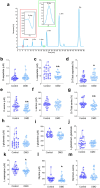D- and L-Amino Acid Blood Concentrations Are Affected in Children With Duchenne Muscular Dystrophy
- PMID: 40329488
- PMCID: PMC12055753
- DOI: 10.1111/jcmm.70495
D- and L-Amino Acid Blood Concentrations Are Affected in Children With Duchenne Muscular Dystrophy
Abstract
Duchenne muscular dystrophy (DMD) is an X-linked disease caused by the absence of functional dystrophin in the muscle cells. Recent untargeted metabolomics studies identified amino acid metabolism alterations as biochemical pathways potentially involved in DMD pathogenesis. Here, in a well-characterised cohort of DMD children and paediatric controls, we investigated by high-performance liquid chromatography (HPLC) the serum profile of a selected pool of amino acids in D- and L-configuration, including L-glutamate, L-glutamine, glycine, L-aspartate, D-aspartate, L-asparagine, L-serine, and D-serine. These amino acids are known to modulate neurotransmission and to play essential roles in energy and skeletal muscle metabolism. HPLC determinations highlighted a general amino acid deregulation in DMD compared to controls, including lower levels of L-aspartate, L-asparagine, D-serine, L-glutamine, and glycine and D-/Total serine ratio. In control subjects, we observed a significant positive correlation between L-glutamine and age, which lacked in affected children. Conversely, in DMD, we observed (i) a negative correlation of L-glutamate and L-aspartate with serum creatinine and creatine kinase levels; (ii) a direct correlation of serum L-glutamine/L-glutamate ratio with the fat-free mass index (as determined by dual energy X-ray absorptiometry) and with specific motor function scores (North Star Ambulatory Assessment); and (iii) no correlations between glucocorticoid treatment or cognitive function and the serum amino acid profile. Our study highlights significant correlations between serum L-glutamate levels, L-glutamine/L-glutamate ratio, and the multidimensional measures of muscle wasting and motor impairment, suggesting that peripheral glutamine-glutamate metabolism can be a suitable biomarker of disease severity and progression in DMD patients.
Keywords: Duchenne muscular dystrophy; D‐aspartate; D‐serine; amino acids; biomarker; glutamate; motor dysfunction; muscle wasting; serum.
© 2025 The Author(s). Journal of Cellular and Molecular Medicine published by Foundation for Cellular and Molecular Medicine and John Wiley & Sons Ltd.
Conflict of interest statement
The authors declare no conflicts of interest.
Figures



Similar articles
-
The metabolomic plasma profile of patients with Duchenne muscular dystrophy: providing new evidence for its pathogenesis.Orphanet J Rare Dis. 2023 Sep 5;18(1):273. doi: 10.1186/s13023-023-02885-1. Orphanet J Rare Dis. 2023. PMID: 37670327 Free PMC article.
-
Serum miR-206 and other muscle-specific microRNAs as non-invasive biomarkers for Duchenne muscular dystrophy.J Neurochem. 2014 Jun;129(5):877-83. doi: 10.1111/jnc.12662. Epub 2014 Feb 12. J Neurochem. 2014. PMID: 24460924 Clinical Trial.
-
Comparative proteomic analyses of Duchenne muscular dystrophy and Becker muscular dystrophy muscles: changes contributing to preserve muscle function in Becker muscular dystrophy patients.J Cachexia Sarcopenia Muscle. 2020 Apr;11(2):547-563. doi: 10.1002/jcsm.12527. Epub 2020 Jan 28. J Cachexia Sarcopenia Muscle. 2020. PMID: 31991054 Free PMC article.
-
miRNA Profiling for Early Detection and Treatment of Duchenne Muscular Dystrophy.Int J Mol Sci. 2019 Sep 19;20(18):4638. doi: 10.3390/ijms20184638. Int J Mol Sci. 2019. PMID: 31546754 Free PMC article. Review.
-
Duchenne muscular dystrophy: a model for studying the contribution of muscle to energy and protein metabolism.Reprod Nutr Dev. 1998 Mar-Apr;38(2):181-6. doi: 10.1051/rnd:19980205. Reprod Nutr Dev. 1998. PMID: 9638792 Review.
References
MeSH terms
Substances
Grants and funding
LinkOut - more resources
Full Text Sources

